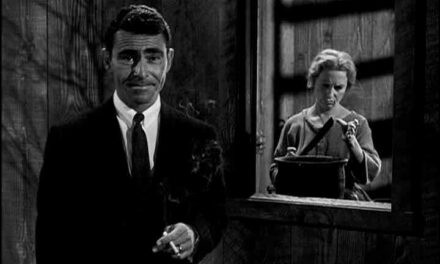Last Monday, Britain invented television… all over again. A load of people watched the same programme at the same time, at the moment of first broadcast. At one point, 9.27 million people, 34.64% of the TV audience, was watching the final denouement of the ITV peak-time drama Broadchurch. Over a third of the TV audience (8.72 million people) watched right through the episode. It broke the record for tweets during a TV drama. On the day of broadcast, the Daily Mail did a two-page spread on who the killer might be. The man later revealed as the murderer was the favourite at 4/7… and only 29 cast and crew members, we were told, knew this in advance! Jubilant TV critics celebrated the British re-discovery of broadcast TV the next day:
I shall never again believe anyone who tells me that vinyl, or film, or books, or newspapers are dead, after the concept of must-see TV was so stirringly reaffirmed, not by some import on an obscure satellite channel championed by the chatterati, but by a mass audience ITV Monday night drama (Nick Curtis, Evening Standard, 23 April p.13).
The Broadchurch phenomenon was a genuine surprise. Here was quality popular drama on ITV, a channel that built had once its reputation on the genre. Yet recently, despite the occasional outstanding series like Foyle’s War and commercial blockbuster like Downton Abbey, ITV had seemed more keen on event TV like The X Factor. Here was an eight part murder mystery that built its audience as it went on. The final episode doubled the normal audience figures for its slot. What were the reasons for its success? Like Hardy (David Tennant) and Miller (Olivia Coleman) in the series, I’ve conducted a rather rambling investigation, pulling in suspects from all over the place, some of whom (like Miller did) I know too well already.

First up is Kudos, the production company. Back at the beginning of March, they had every independent’s nightmare: the first episodes of major productions scheduled directly against each other. On Sunday 3 March at 9pm, BBC1 launched Kudos’s Mayday. Strip scheduled over the week, this was… a murder mystery in a small community. The victim was a teenage girl, abducted when she was cycling to feature in the May Queen Parade. Many of us hoped for a reworking of the Wicker Man, but were disappointed. The next evening, against the second Mayday, Kudos’s Broadchurch kicked off on ITV: a murder mystery, set in small town, the victim an 11 year old boy. Analysis of the viewing figures shows that around 2 million viewers started with Mayday and switched to Broadchurch, with Broadchurch averaging a 28.1% share and 6.78 million viewers against Mayday’s 17.85% average share. The day before, Mayday’s first episode had out-rated the ITV period drama Mr Selfridge, and had had a 25% audience share.

Why did Mayday disappoint and Broadchurch succeed? It is down to our old friend plausibility. Despite their similarities, Mayday played for grand guignol, that distinctive mixture of naturalism and excess that was the mark of theatrical melodrama. There was Peter Firth, the stalwart of Kudos’s Spooks, playing a depressed voyeur whilst his wife (Lesley Manville) flapped around him. Both are excellent actors, both had unrewardingly stereotyped roles. Their lugubrious dog had a better part. Obviousness was written all over it, an effect not helped by the quasi-mystical references to the surrounding forest. Fans of Cold Comfort Farm, Stella Gibbon’s parody of the genre, must have been watching in the expectation of there being “something nasty in the woodshed”.
Broadchurch also used the methods of melodrama, certainly, but not in the same way. The mise-en-scene used a most extraordinary range of evocative settings which bodies forth aspects of the characters… but didn’t bludgeon you with their significance. Broadchurch’s police station was one of those contemporary buildings where the architects had just tried too hard: like a pretentious arts centre, it was full of weird spaces like the incident room itself with porthole windows set too high for anyone to see out. The home of DI Ellie Miller the local detective and her (spoiler alert) murderer husband Joe was a failed DIY project complete with a rambling shed complex in the back garden, where the eventual unmasking of Joe’s guilt took place. But such was the understated way in which these settings were used that in the penultimate episode Ellie Miller could berate her husband for his general uselessness by pointing out that he still hadn’t redecorated the bedroom after a year. It was a risky line, but it worked. In Mayday, such a line would have been laughed off the screen.
That’s the case for and against Kudos. The next suspect is the first series of The Killing (the Danish Forbrydelsen, of course). This presumably is the kind of thing that Nick Curtis refers to in his review as ‘championed by the chatterati’, which raises some interesting questions. Of course there are similarities which the writer Chris Chibnall is not afraid to acknowledge. This was a murder drama that concentrated on the family of the victim: their mourning was a central feature, with the disparate responses of mother and father. There was even the same suspect as the first Forbrydelsen: the ever-helpful assistant in the victim’s father’s construction company (well, plumbing firm, but the same idea). But there were two major differences, one in atmosphere and the other in plotting.

Atmosphere first: the actors came with an inevitable freightf the familiar. There was David Tennant who’d played Doctor Who (well known also for his heart problems) and popped up in the ad breaks messing around with Richard Branson’s broadband TV. Olivia Colman was the detective cousin of that over-eager PA in Twenty Twelve. The difference is that both were being asked to do far more than in those previous roles. Both were characters who create instability around them. Tennant had to be driven and managerial, suppressing so many emotions; and Colman had to express how she was pushed and pulled by loyalties to job, friends and family, barely coping.

But they were familiar faces nonetheless, and with the first series of The Killing we didn’t recognise a soul. The performances came over as totally convincing to ‘the chatterati’ as a result. Broadchurch is popular drama, however, and this contrast shows something important about its star system: part of its pleasure lies in knowing the actors but seeing them push further, using their familiarity of their physical shapes to force us to pay attention to every nuance of their performance. And as we see more Scandinavian drama, we chatterati begin to experience the same thing, seeing Forbrydelsen’s Soren Malling in Borgen, for instance… and for Danes, Sofia Grabol herself is a familiar actor. So the familiarity of performers is not the enemy of quality: quite the reverse. However, Curtis’s criticism still makes a valid point about lingering suspicions that popular TV cannot be quality TV.
Now to the plotting. Broadchurch got away with some extraordinary parallels which bore down on the characters. They may well be the stuff of the next series, the planning of which was just as much a secret in the industry as the identity of the suspect was to the viewers. Nige (Joe Sims), the plumber’s mate, behaved oddly, at one point kidnapping a dog belonging to Susan (Pauline Quirke), another suspect, and menacing it with a crossbow. Susan herself was a chain-smoking loner, living on the caravan site. Both had much to explain. The explanation, when it came, was another melodramatic turn that succeeded in establishing itself as entirely plausible, not least through Quirke’s performance as Susan. Nige turned out to be Susan’s child, taken away for adoption at birth because Susan’s husband had been abusing their daughter. She had known nothing about it. This emerged under interrogation, with Ellie Miller discovering a ruthlessness in the process that seemed to surprise her as much as the viewer. “How could she not know?” asked Miller at the end of the process… exactly the same words that were addressed to her by the murdered boy’s mother in the following episode. A clear parallel is drawn between Susan and Ellie at this point: both unwittingly harbouring hidden abusers as husbands. Here’s where Broadchurch diverges from The Killing. It creates a detective rooted within the community, and, it turns out, with a killer rooted in her family. Her immediate reaction is that she should move away: Hardy tells her that’s impossible. She belongs. So where to next for Broadchurch?
Our third suspect in the Broadchurch case is Britain itself. Or rather, the current state of Britain. A deep recession is driving people to TV as cheap and reliable entertainment. So there was a ready market for Broadchurch. It happened to be scheduled in the coldest early spring for many years, adding another incentive to stay at home watching TV. Sustained bad weather can added a million viewers to the most lacklustre of shows. So to an extent Broadchurch was fortunate in its scheduling. There are many decent shows around, however, but only this one became a phenomenon. Thanks to the research of a new company, SecondSync, we have a further insight into how and why this happened. SecondSync analyse traffic on Twitter, discovering that Broadchurch generated almost two thirds of the Twitter traffic during its broadcast, and was by far the most tweeted drama that the company had yet researched. There were more than a quarter of a million tweets during the broadcast, from 137,318 unique users. Of this group, 72% were women. The peak moments for tweets follow the pattern of the ad breaks closely, with the biggest spike taking place more or less as the titles rolled with over 8000 per minute. So the chatterboxing identified by the Telescope report is working around this ‘live’ broadcast of a drama in the way that it does around live event TV like sport or talent shows. This is TV that drives you to talk about it. Tweeting is the electronic version of making comments to the people watching in the same room. Maybe this is a case of backwards remediation… but certainly it shows that two-screen viewing is an increasingly important habit, in relation to drama as well as event TV.
So is Broadchurch a sign that traditional broadcast TV is still a cultural force, or just a more-than-usually effective drama that manages to pull off the trick of being both popular and quality? I would say both, but then I don’t dismiss broadcast TV as easily as some seem to. American readers may find this hard to believe, but broadcast TV is still a force over here in Europe. My only regret is that the location tourism spinoff from the series will make it very hard to get to stay in the Bridport area any time soon. I remember once sitting outside a pub there sharing a table with Roy Jenkins and a bottle of claret… but that, as they say, is for the next series!
JOHN ELLIS is Professor of Media Arts at Royal Holloway University of London. He is the author of Documentary: Witness and Self-revelation (Routledge 2011), TV FAQ (IB Tauris 2007), Seeing Things (IB Tauris 2000) and Visible Fictions (1984). Between 1982 and 1999 he was an independent producer of TV documentaries through Large Door Productions, working for Channel 4 and BBC. He is chair of the British Universities Film & Video Council and leads the Royal Holloway team working on EUscreen. His publications can be found HERE





